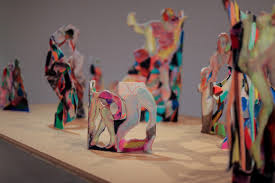Visiting Hastings Contemporary via robot
Being in total lockdown myself, the robot experience at Hastings Contemporary seemed remarkably apt. I had been booked in for a private tour to get to grips with the system – which proved to be remarkably easy – though getting used to just who you are when you log on was at first a little disconcerting. Those who recall Silent Running may remember the three little robots, Huey, Dewey and Louie. At Hastings Contemporary I suddenly became one of them with a very similar sense of articulation. Using the arrows on my keyboard I was able to move forward and backward, and then turn left or right with the side arrows. There is also a facility for lifting the camera – my eye – to a higher vantage point. After basic instruction I was able to tour one of the galleries by myself. The present exhibition includes work by Ann Ryan entitled Earthly Delites. I found it easy to navigate the various tables on which the pieces are displayed, and the robot has a zoom feature which allows for close up inspection of objects. This is splendid as it gives a much better focus than one might achieve actually wandering round the gallery when there are so many more things to distract you.
The real advantage over the virtual tours offered by other art galleries and museums is that this is your own, live, tour, not a pre-recorded video. If things go wrong – you bump into a table – then this is real.
The system now being tested is unique to Hastings and has been installed by Bristol Robotics. Praminda Caleb-Solly, Professor for Assistive Robotics and Intelligent Health Technologies at the Bristol Robotics Lab, UWE said “I am absolutely thrilled to team up with Hastings Contemporary as part of our Arts and Humanities Research Council D4D project to provide people who are socially isolated the opportunity to enjoy art via the telepresence robot. This is an excellent example of how robotics technology can be used to support people in difficult situations such as we are currently experiencing. There are other applications for use of telepresence robots within health and social care and I look forward to learning from our experiences at Hastings to apply elsewhere.”
Though I was privileged to get an early insight into the system, the gallery very much hopes that this will soon be opened to a much wider audience. Those self-isolating will be able to book time slots for a visit and it will be possible for individuals to set up a visit and then invite others to join them. They will then obviously follow the leader round the gallery but will be able to interact immediately to pause or move on. The educational possibilities are enormous and only just beginning to be explored. Teachers will I am sure be excited at the prospect of involving whole classes in virtual tours, and once the system is exported to other centres and possibilities are endless.
The gallery is planning, in addition, further ways to use innovative technologies to ‘flip’ the gallery inside out so that people can continue to benefit from its work while stuck at home, including developing a new online hub of art and mindfulness resources, with the children of key workers in mind; creating bespoke digital art lessons and creative learning activities for many of the now closed schools in Hastings; and virtual 3D renderings of its three postponed Spring shows, Victor Pasmore: Line & Space, Stephen Chambers: The Court of Redonda, and Quentin Blake: We Live In Worrying Times.
To visit the gallery and be one of the first people in the UK to experience this technology please email info@hastingscontemporary.org.

